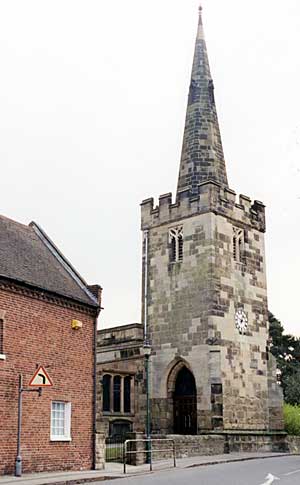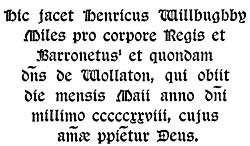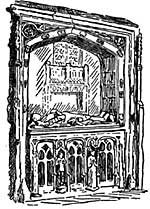The Church.

St Leonard's church, Wollaton (photo: A Nicholson, 2002).
THIS Church is dedicated to St. Leonard, and it is a curious fact that a certain William de Mortein, whose family owned the Wollaton and Cossall estates in the time of Edward I., died on St. Leonard's day, in the 12th year of that king's reign. From this, the question has arisen—did the date of William de Mortein's death lead to the selection of St. Leonard as the patron saint of this church? It would seem from the Torre manuscripts that the dedication to St. Leonard is a still more ancient one, for it is stated therein that "the church of St. Leonard is an ancient rectory belonging to the patronage of the Morteyns and after (Edward II.) of the Willoughbys."
There are no very striking architectural features connected with the present fabric, which is chiefly of the Perpendicular Period, and contains chancel, nave, north and south aisles, clerestory, south porch, and a chapel (a prolongation of the south aisle) on the south side of the chancel, now occupied as a family pew by Lord Middleton. The oldest part, which dates from the 14th century, is the three eastern bays of the north arcade. At some period this arcade has been lengthened westwards by one arch, and now consists of four bays instead of three. The tower, which is at the west end and is surmounted by a spire, is peculiar, being carried on pointed arches, north and south; possibly with a view of allowing processions to pass round the building. Another theory has also been advanced, viz., that when the north arcade was prolonged, it had the effect of pushing the tower westward, thus causing it to encroach on the adjoining roadway, and that the public demanded that
their right of way should not be curtailed. Hence it arose that the tower was pierced in the manner described, If this difficulty as to the roadway ever existed, it has long since been overcome; and the tower now stands within the precincts of the churchyard. There is a small outside south door, of the Early Decorated Period, leading into the south chancel chapel, which contains a marble altar table, supported on a pretty, wrought-iron framework. It is recorded in the church books that the iron work was repainted in the year 1846. This altar was subsequently removed to the chapel in the Cossall almhouses, whence it was brought back by the present Lady Middleton.
Only one seat of the original sedilia now remains; the floor of the chancel has been raised as the seat is very low. The piscina is modern. There is a painted reredos, or altar piece, of carved oak and moulded plaster in three compartments or panels.
The church was restored in the years 1885 and 1886, at a cost of £2,500, under the supervision of Mr. Hodgson Fowler of Durham, when the south aisle was added. The two clerestory windows on this side are made up of the heads of larger windows, originally in the south wall of the church, which were cut down in size in order to accomodate the bays of the new south arcade. The space within the altar rails was also enlarged. Thoroton refers to an "Alabaster Tomb under an arch in the middle of the church," to Matilda, wife of Johannis Dabrishcourte (sic). This is no longer to be seen, but traces of it were found during the restoration. The font is a modern one, given by the parishioners in memory of the present rector's wife, sister of Lord Middleton.
Dividing the chapel from the chancel, and beneath an arch, is the stone tomb of Sir Henry Willoughby. His effigy represents him in plate armour, and with diminutive figures (two on each side of him) of his four wives; beneath is a cadaver and on the chamfer is this inscription:
 |
 |
The effigies still shows traces of having been painted.
Above is a shield of arms, quartering with Willoughby, those of Marmion, Mountfort, Freville, Buttetourt, Kilpeck, and Zouche.
On the north side of the chancel is a large mural tablet, to Henry Willoughby and his wife Anne, also showing a shield with numerous quarterings. This man was killed in the riots at Norwich (temp. Ed VI.).
Within the altar rails, and let into the south wall, is a slab with the following inscription carved in relief, in very pretty lettering.
| Perci Bridg |
) ) |
Wylluhby qui Ob. Aug. 23, l643. qua obuit July 16, 1629. |
| Toro Tumulo |
) ) |
coiuere in uno. |
| Duplici coniuncti connubio Ignoscat illis omnia Qui nostra tulit crimina. |
This is in memory of Bridget, the heiress of Sir Francis Willoughby, the builder of the hall, and her husband Sir Percy Willoughby of Kent.
The inscription has been thus paraphrased by a member of the Thoroton Society, Mr. John Russell:— "One tomb in death as erst in life one bed Holds man and wife in double wedlock bound; May He on whom our load of sin was laid Pardon what e'er of sin in them was found." On the north side is a handsomely carved stone canopied tomb, to Richard Willoughby, who married Anne, daughter and co-heir of Simon Leek, of Gotham or Halam, but had no issue. This tomb is evidently by the same sculptor as one in Strelley church to John de Strelley, who married Saunchia Willoughby. Richard Willoughby died 7 October, 1471, and his wife died in 1467. He directed by his will that he should be buried in Wollaton church, on the north side of the high altar before the image of St. Leonard. On the canopy of this tomb are shields showing the Willoughby arms impaling those of
| Leek, viz: | — Argent, on a saltire engrailed sable, nine annulets of the first. |
| Foljambe | — Sable, a bend between six escallops or. |
| Annesley | — Paly of six argent and azure, a bend gules. |
Beneath the canopy, on a Purbeck marble slab, are well executed brasses of the squire and his lady; he is clad in an elaborate suit of plate armour, with his crest, an owl, on his helm, his hands in an attitude of devotion, his sword worn diagonally, a misericorde at his right side, and long pointed sollerets on his feet; his elbow-guards are conspicuously large. She wears long robes from her shoulders to her feet, cords and tassels, a cross suspended round her neck, and the heart-shaped headdress of her period; at her feet are depicted the two customary dogs. Above the heads of the squire and his lady are their respective arms, but the scrolls have been removed. Here again is a cadaver beneath the slab. On the outside north wall, immediately at the back of the tomb, is inscribed :—
![]()
He appears to have been the first of the family to be interred at Wollaton.
There are also several other mural monuments to various members of the family, one of which is by Westmacott, to Henry, sixth Lord Middleton; and on the wall of the south aisle is one to Henry Smythson, who acted as "architector and surveyor unto the most worthy house of Wollaton," at the time the hall was built.
In the Torre manuscripts it is recorded that a chantry was founded by Sir Richard de Willoughby the elder (judge of Common Pleas), in 25 Edward III., with two chaplains celebrating at the altar of St. Anthony and St. Nicholas. This chantry was granted to Wm. Nevill, on 24 July, 3 Edward VI. In the reign of Henry VI., the executors of the will of Richard Willoughby (of whom there appear to be no fewer than seven!) obtained the king's license of amortizing, and granted two houses near the rectory, also certain lands of the value of £10 a year for "one perpetual chaplen to celebrate dayly at the high altar of St. Leonard of Wollaton, etc." By the same will, this presentation was vested in the Willoughby of Wollaton for the time being, if of age, otherwise the prior of Beauvale had the presentation "for that turn;" and the will further directed that the chaplain should "celebrate daily for ever for the good estate of the said Richard while he lives and for his soul after his decease;" and that the chaplain should also observe certain anniversaries ; the anniversary of Richard Willoughby's death being one of them.
The following testamentary burials belong to Wollaton:—
"28 Feb., 1427. John Hancok, rector, to be buried in the church."
"15 Sept., 1469. (Date of will) Richard Willoughby, Esqr., to be buried in the church at the end of the high altar on the north, before the image of S. Leonard, against the new monument by himself lately built; and bequeathed to the church of Wollaton one jocale of silver-gilt with a beryll in it for to carry and shew the sacrament of the altar on the feast of Corpus Christi."
"17 Apl., 1517. Robert Laurence parson of the churches of Wollaton and Haverham, to be buried after a Christian manner."
The registers date from 1576. They contain some curious entries, of which, perhaps the following is the most remarkable— "1685, John Booth of Smalley, co. Derb and Jane Chapman ye old Virgin of this parish were married 4 Aug:"
On 14 June, 1787, the Hon. Richard Lumley Savile, p. St. Geo: Hanover Square in the county of Middlesex, and Hon. Henrietta Willoughby, p. St. Marylebone in the same county, were married by special licence in the house of the Rt. Hon. Henry Lord Middleton, in the parish of Wollaton, by J. Willoughby, minister.
LIST OF RECTORS AT WOLLATON.
| Rectors. | Patrons. | |||
| 2 Apl., 1237 | Blyas de Elnivechirch | Dame Emmet de Morteyn | ||
| 17 Mar., 1290 | Adam de Wellum | Roger de Morteyn | ||
| Roger de Willoughby | Rich, de Willoughby, miles | |||
| Resigned for the Church | of Gamelston. | |||
| 1 Apl., 1340 ) 7 Feb., 1341) |
Robert de Rempston | Rich, de Willoughby. Died | ||
| 16 Jan., 1361 | Hugo de Willoughby | Ditto Resigned | ||
| 15 Dec., 1375 | Johannes, fil Ric. de Willey | Matilda, widow of Richd. | ||
| Willoughby . . . | ||||
| John Hancok | Died | |||
| 3 M.... 1427 | John Woodhouse | HugoWilloughby.arm. Died | ||
| 22 Sep., 1446 | Rich. Dwygge ... | Ditto Ditto | ||
| 27 Oct., 1448 | Will. Husse | Ditto Ditto | ||
| 17 Sep., 1460 | Robt. Netham ... | Rich. Willoughby, arm. Died | ||
| 29 Sep., 1466 | Thos. Tyen, or Tewe | Feoffees of Richd. | ||
| Willoughby, arm. Resigned | ||||
| 21 Apl., 1486 | Robt. Ilkston | Margaretta Legh, formerly | ||
| wife of Robt. Willoughby. | ||||
| Died | ||||
| 12 Mar., 1489 | Will. Jekston ... | Ditto Resigned | ||
| 9 Aug., 1491 | Robert Welby | Hy.Willoughby, miles Ditto | ||
| 14 Oct., 1496 | Robert Laurence ... | Ditto Died | ||
| 17 Sep., 1517 | Richd. Smyth | Ditto Ditto | ||
| 30 May, 1565 | Rad. Dickon | Exors. of Hen. Willoughby, | ||
| armiger. Resigned | ||||
| 30 May, 1571 | Adam Squyer, M.A. | Francis Willoughby, arm. | ||
| Resigned | ||||
| 15 Sep., 1576 | Robert Aldridge | Ditto Died | ||
| (?1590) | ||||
| 4 Dec., 1616 | Percival Hinde ... | Exors. of ditto Ditto | ||
| 29 Nov., 1628 | John Wagstaffe ...... | Percival Willoughby, | ||
| 1658 | John Heywood ...... | Resigned | ||
| 15 Nov., 1661 | Saml. Kendall, M.A. ... | Francis Willoughby, miles, non-subscriber | ||
| 24 Mar., 1662 | Saml. Kendall ...... | Ditto | ||
The above from Torre MSS.
| 1679 | George Antrobus |
| 1708 | John Lloyd |
| 1720 | John White |
| 1742 | Geo. Staunton Brough |
| 1766 | Isaac Pickthall |
| 1798 | George Sanders |
| 1838 | Francis Hewgill |
| 1846 | C. J. Willoughby |
| 1876 | H. C. Russell |
In the village, not far from the church, is a very old dovecote, which still fulfils the purpose for which it was originally intended. On either side of the narrow doorway can be detected the initials F.W., built into the brickwork. These are said to be the initials of Sir Francis, who built the hall, but there have been a good number of Francis Willoughbys at various times, so too much reliance must not be placed on this assertion.
(1) Thoroton remarks, "mistaken for Bannerettus." "It
was formerly the custom for a sovereign on the field of battle to reward
a knight, who was the leader of fifty men-at-arms, besides archers, for
any particular act of gallantry, by tearing off the points of his pennon;
thus converting it into a banner. Thenceforward the knight was entitled
to emblazon his arms upon a square shield, and was styled a Knight Banneret."—
Cussan's Handbook of Heraldry, 3rd ed., 1882, p. 270.
